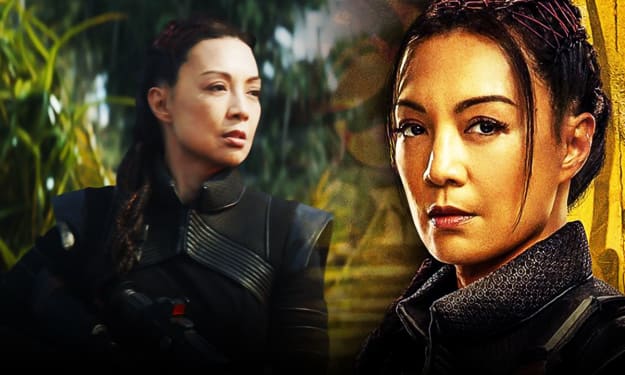10 Things You Didn't Know About Mandalore
A History Lesson

The warrior creed of Mandalore has gained a great deal of popularity since the debut of The Mandalorian. These armored, battle hardened soldiers have a long history of combat and conquest. Led by their leader, the Mand'alor, the Mandalorians are renowned and feared across the galaxy. While there are those who prefer to use their talents and equipment in pursuit of credits, some of them serve a higher calling. While Star Wars fans patiently wait for the next season of The Mandalorian, here are ten obscure facts about Mandalorians you may not have known taken from both current established canon as well as the Legends stories of the Expanded Universe.
10. Alien Ancestors
The most iconic piece of Mandalorian armor is without a doubt their helmet. Designed for functionality, the helm still harkens back to a more ancient time. The trademark T-visor, which would carry on into the Phase I helmet of clone troopers in the G.A.R., bears a legacy thousands of years old. The original Mandalorians are a race of people native to the planet Coruscant called the Tuang. These tall, grey skinned, yellow-eyed aliens are proud warriors who worship war as the truest expression of "survival of the fittest." Their helmets are built to suit their long, prominent chins and wide set eyes, with the result being the iconic T-visor still used in Mandalorian armor for thousands of years.
9. Discovery
In 7,000 BBY, Te Sol'Yc Mand'alor claims the title of "sole ruler" and leads the Mandalorians on a conquest across the galaxy. Up until now the Mandalorians have lived in relative obscurity on the planet Roon. Te Sol'Yc believes that their warrior gods demand more from his chosen people. Considering weakness and peace a sin, Te Sol'Yc takes the title of Mand'alor, meaning "sole ruler," and rallies his best warriors to form the Mandalorian Crusaders. Taking planet after planet, the Mandalorians obliterate several sentient species and cultures until coming across a planet in sector O-7 that is rich in natural resources. Most importantly, it is rich in a metal ore that is easily mined and forged but can resist virtually any weapon in it's purest form.
8. Gift from the War Gods
This newly discovered metal is immediately seen as a gift from the Taung war god Kad Ha'Rangir. Called beskar by its discoverers, the metal becomes a staple of Mandalorian culture. When forged into armor, beskar is light and flexible enough to not restrict the wearer's movement while keeping them safe from standard blasters and melee weapons. Many in the Mandalorian culture see this gift from Ha'Rangir as an affirmation that the place of the Mandalorains in the galaxy is that of soldiers and conquerors, and they have been rewarded for returning to their warrior wars.
7. Skull Symbol
The gift of beskar and the planet that becomes Mandalore does not come without a price. The apex predator of this new world is a fearsome beast called the Mythosaur. This huge reptilian creature is described as being the size of a small city and features large curving horns that begin behind its eyes and point downward toward its mouth, similar to tusks. Te Sol'Yc, now calling himself Mandalore the First, gives his warriors the task of taming and culling these ferocious beasts. In the end, the Mandalorians drive these great beasts to extinction. Their massive skulls, scattered across the landscape of Mandalore, become synonymous with the warrior culture of the Mandalorians. The intimidating visage of these skulls adorn Mandalorian ships, weapons, and armor for thousands of years, including a pauldron of Boba Fett during his time hunting for the Empire.
6. Symbols of Power
Generations of Mand'alor have wielded various cultural items to assert their role as leader of the tribes. After Mandalore the Indomitable is killed in the jungles of Dxun, the moon of Onderon, his helmet is all that remains of his body, and the Mandalorians are left leaderless. The Mask of the Indominable is found by a Taung and claims it as his own, giving himself the name Mandalore the Ultimate. The helmet is worn by the leader of the Mandalorians until the time of Revan when he kills the Mandalore and takes the helmet as his own. Revan believed that without it, the Mandalorians would crumble from within and be wiped out. However Tarre Vizsla, the only Mandalorian to be inducted into the Jedi Order, led his people with his signature black-bladed lightsaber and briefly united the clans against the enemies of Mandalore. After Vizsla's death, and a heist in which Mandos invaded the Jedi Temple and stole the saber, the Darksaber would come to symbolize Mandalorian leadership and be wielded by the true leader of Mandalore.
5. Republic Invasion
After the Sith are seemingly annihilated a millennia before the rise of the Empire, the Republic sets about eliminating any other threats to its sovereignty. Mandalorians, with their aggressive nature and checkered past with the Republic, are seen as a threat and invaded. Without a strong Mand'alor, the Mandalorian tribes are riddled with betrayal and infighting. This leads to mounting losses against Republic forces and a treaty is signed to end the bloodshed. After centuries of war and turmoil, the ecosystem of Mandlore is decimated. There are mass extinctions across the planet, not just of animals, but of virtually all plant life. The planet is plunged into a drought that persisted for centuries, with many Mandalorian tribes believing the planet to be cursed.
4. Cultural Shift
The costly war with the Republic leads to many Mandalorians questioning their ancestral ways. A movement called the New Mandalorians seeks to move past battle and bloodshed. Many believe they are propped up by the Republic in an attempt to usurp the Mandalorian ways from within. This leads to a huge cultural shift and divide among the people. As the New Mandalorians gain power and political status, they begin using terms for leadership from outside systems. The leaders of the New Mandalorians use terms like King and Duchess instead of Mand'alor.
3. Capital Change
The rise of the New Mandalorians was not swift or easy. While they enjoy the support of the Republic and the Jedi, they receive staunch opposition from within Mandalorian society. Many view those who sue for peace as heretics or cowards. Eventually, a violent Civil War breaks out on the planet while roving bands of Mando marauders plunder rural areas on the moons of Mandalore. With aid from Coruscant, the New Mandalorians emerge victorious with those who still follow the warrior ways of old being outcast to the moon Concordia where most of them become mercenaries or murderous thugs. To signify their newfound leadership of the planet, the New Mandalorians move the planetary capital from its long time home in Keldabe to their own seat of power, Sundari.
2. Mando Murals
Even for a peace loving bunch, the New Mandalorians are not above reliving past military victories. Several large murals decorate the walls of the throne room as well as several other areas of the palace. These murals depict the Mandalore of old from slaughtering grotesque looking Jedi on the battlefield. The city of Sundari is long considered to be the pinnacle of Mandalorian architecture and artistic expression. Public art displays of Mandalorian history, as well as unique building designed to maximize space within the domed city, are trademarks of Sundari.
1. Decimated Planet
After the environmental catastrophe some 700 years before the Clone Wars, the population of Mandalore seeks refuge in bio-domed cities. Seeking escape from the dry, arid, and borderline toxic atmosphere, these domed cities are a safe haven for the New Mandalorians. While allowing Mandalorian art and architecture to flourish, the decimation of their planet also forces them to import their food and drink. This leads to a dependency on alien assistance that few Mandalorians see as acceptable.
Bonus: Current Canonical Status
While much is known about Mandalore's ancient history and up to the Clone War, the status of the planet and the people become hazy after Order 66. Canonically, the most recent we have seen Mandalore is during the Star Wars Rebels arc in which Sabine Wren gives Bo-Katan the Darksaber, with which she can unite the clans and lead her people. However, from what we've seen in The Mandalorian, with references to the Purge and the "Night of a Thousand Tears," it doesn't seem to have gone well for Bo or the rest of Mandalore. Boba Fett contests that "the Empire turned that planet to glass," referring to Mandalore. Even the Children of the Watch, religious zealots that they are, are fearful to return to their ancestral homeworld, fearing a curse that kills any Mando who attempts to return home. Hopefully, future content, including Season 3 of The Mandalorian, will shed some light on the fate of this planet and its proud people.
Written By Weston Erickson
Source(s): MetaNerdz Lore, Wookieepedia
Syndicated From Culture Slate






Comments
There are no comments for this story
Be the first to respond and start the conversation.